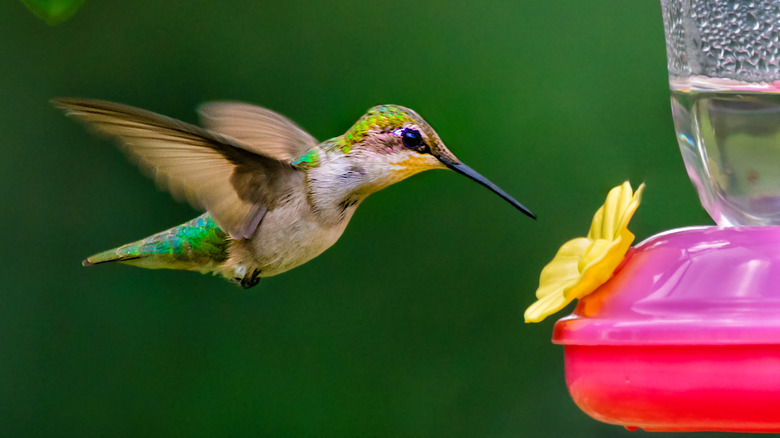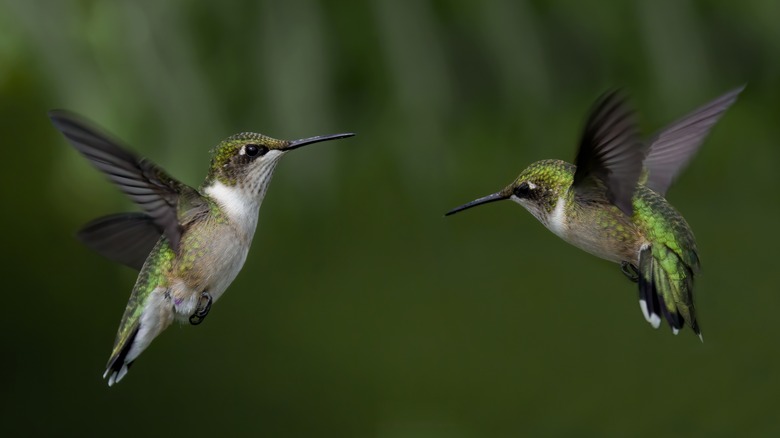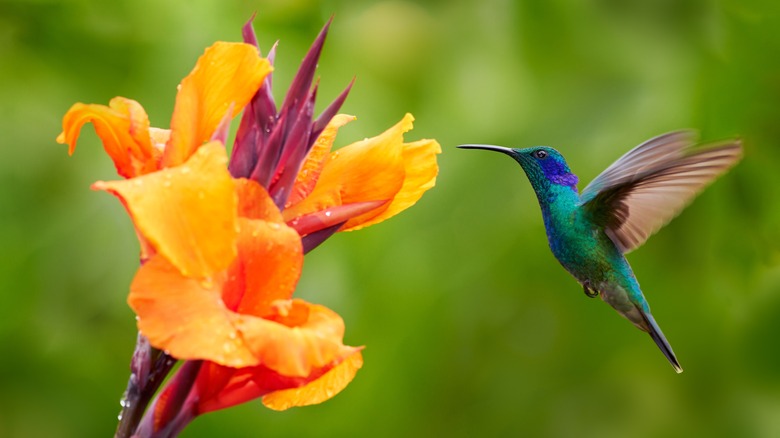The One Thing You Should Never Add To Your Hummingbird Nectar
From dipping extra-long beaks into homemade nectar to observing their territorial behavior, hummingbirds can be fascinating to watch at backyard feeders. They come back again and again, often jockeying with other birds for a chance to get a sip of the sugar water filling in for natural nectar. Making this essential part of the hummer's diet is simple. Dissolve ¼ cup of pure white granulated sugar into 1 cup of spring water (per The International Hummingbird Society), but there's something you should always leave out of the mix. Even though it's a widely known fact that hummingbirds are attracted to the color red, never add red dye to your sugar water.
What's so wrong with red dye? Experts like Sheri Williamson, who wrote "Attracting and Feeding Hummingbirds," discourage adding any type of dye, even food coloring, as it may potentially be harmful to hummingbirds. That's why mixing up a batch of homemade nectar is far better than buying premade products containing red dye. Furthermore, the coloring is simply not necessary and a waste of money, according to Williamson. Just make sure to buy a feeder with red somewhere on the base and that should be enough to attract hummingbirds while they're migrating through or residing in your area.
Why hummingbirds need an abundance of nectar
As far as their actual diet is concerned, hummingbirds thrive on small insects including spiders (and then use the spider webs as part of their tiny nests!) and tree sap along with nectar. While they get protein from the insects they consume, nectar makes up about 90% of their required intake to supply their little hyperactive bodies with energy. During their spring migration, cold fronts can unexpectedly cause hummingbirds to need more nectar than usual to stay warm. During the summer, especially in very hot climates, they rely on artificial nectar from feeders when fewer and fewer flowers are blooming.
If you're wondering how come they can consume so much sugar without falling ill, that's an excellent observation. There's also a good answer for that. Since a hummingbird's heart beats so fast — 1,260 beats per minute — their bodies are designed by nature to thrive on energy gleaned from sugar. Their wings also move extremely fast and their swift flight from food sources to trees, all the while battling other birds to stake out their territory, requires a lot of sweet fuel to keep them going.
Things other than nectar to attract hummingbirds to your yard
Now you know not to add red dye to your homemade hummingbird nectar, and to buy a feeder with an attractive red base instead. There's no denying, however, that it's also entertaining to watch these petite-yet-feisty birds feeding on nectar naturally in your garden. In addition to red blooms, they can also be attracted to orange and yellow flowers. Salvia, zinnias, bee balm, red yucca, and cardinal flowers are some of the many that can draw hummingbirds to yards. They also relish coming across all types of trumpet shaped buds since their beaks can access nectar from those blooms much easier than insects like bees competing with them for a sip of sweetness.
Another fun way to draw hummingbirds to your yard involves water. More specifically, hummingbirds love misters in the summertime. They cool themselves and clean their feathers by flitting in and out of the mist. If you don't want to buy a dedicated mister, check your lawn sprinkler to see if it has a mist setting to get the attention of a bevy of these little birds. With a little effort, you can create a healthy habitat for hummingbirds while also enjoying their antics.


